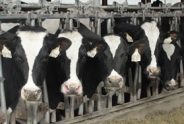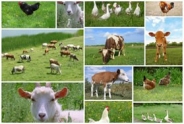5-Point Checks for Small Ruminants
Amy Barkley, Team Leader & Livestock Specialist
Southwest New York Dairy, Livestock and Field Crops Program

Internal parasites are a common problem for small ruminants. No matter the production system, time of year, or breed, it is fair to say that all small ruminants have a parasite load to some extent. Though there is a wide variety of internal parasites out there, the internal parasite of greatest concern is the barber pole worm (Haemonchus contortus). If an individual has high loads of this parasite, the resulting volume of blood drawn by the worms results in anemia and lack of overall nutrition getting to the animal's body. Other parasites are less likely to, but can, become problems in production scenarios as well.
Past recommendations, including the monthly treatment of an entire flock, and treating before moving to new pasture, are now antiquated as research has shown that these methods increase the potential for parasite resistance. As resistance to dewormers grows, an integrated pest management approach is called for. In addition to more intensive pasture rotation, selective breeding for resistance, and limiting access to pastures immediately surrounding the barn, a 5-point check can be used to determine the need to deworm select individuals in a herd or flock.
A 5-point check is a comprehensive analysis of an animal's condition to determine if it is exhibiting signs related to a potential high internal parasite load, using an evaluation at 5 points over the animal's body. Not all animals will exhibit all signs, so a combination of the intensity of the signs present and experience can help producers make timely management decisions.
1.) The Eye: FAMACHA (FAffa MAlan CHArt) Scoring
This scoring system looks primarily for the effects of the barber pole worm (Haemonchus contortus) by comparing the color of the eyes' mucous membranes to a known graded color standard. This indicates the level of anemia within an animal. The scores range from 1-5, with 1 being normal, and 5 being the most clinically severe. Those animals which exhibit scores of 4 and 5 must be treated with an effective dewormer, but the other checks in the 5-point system will indicate which individual animals showing score of 3 should be treated as well.
FAMACHA certification courses can be taken in-person through your local extension office, or online through the University of Rhode Island (https://web.uri.edu/sheepngoat/famacha/). This course will teach proper scoring techniques and deworming decision-making tools. Completion is necessary for the procurement of a FAMACHA card.
2.) The Jaw
Anemia in small ruminants is mostly the result of a blood-feeding parasite infestation, with the primary parasite being the barber pole worm. Bottle jaw is the result of severe anemia, where the lack of blood proteins and/or improper blood pressure can result in fluid buildup below the lower jaw. If bottle jaw is seen in a small ruminant, confirm the level of infestation through the FAMACHA scoring system, and treat those animals affected.
3.) The Back
The back is scored on a scale of 1-5 using a body condition score (BCS) series to determine the nutritional status of an animal, where animals scoring higher on this scale have a higher body condition (more muscle and fat). The score should fall between a 2.5 and a 4, with lower scores indicating a potential health problem. Instructions for proper body condition scoring can be found through the Michigan State University Extension (https://www.canr.msu.edu/news/body_condition_scoring_in_goats).
4.) The Tail
Fecal quality can help determine the health status of an animal. Many worms are known to cause scours, and therefore, the degree of fecal soiling can be indicative of a parasite load. This score is on a scale of 0-5, with 0 being no fecal soiling and 5 being very severe, watery diarrhea that extends to the hocks. Animals with scores of 3-5 should be considered for treatment, though it's important to note that a high score may be indicative of another condition, such as stress or diet. It should also be noted that evidence exists that some animals with genetic resistance may present with diarrhea as a result of their heightened immune response against the parasites.
5.) The Coat
A healthy animal's coat should be even, full, and lustrous. Lack of proper nutrition due to internal parasite feeding can result in a rough, dull hair coat.
---
In a herd or flock, those animals which are under biological stress are most likely to be susceptible to the negative effects of worms. These include ewes or does in late pregnancy or lactation and young lambs and kids. If there are not enough resources available on-farm to make a 5-point check on all members of a herd or flock, consideration for deworming should focus on these animals, as they are most likely to have the highest parasite loads.
This article was written by Livestock and Beginning Farm Specialist, Amy Barkley (amb544@cornell.edu / (716) 640-0844). More information on small ruminant parasite management can be found by visiting the Cornell Small Ruminant Parasite Research Site at http://blogs.cornell.edu/smallruminantparasites/.
Upcoming Events
Boots in the Barn: Cornell Dairy Research Updates
January 13, 2026
January 20, 2026
January 27, 2026
February 3, 2026
February 10, 2026
February 17, 2026
February 24, 2026
Join us for some or all!
Advanced Hoof Health Program
January 15, 2026
Belfast, NY
Who should attend?
- Professional hoof trimmers
- Dairy farm owners or managers in charge of farm foot health
Topics include:
- How to Create a Strategic Trimming Program for your Dairy
- The Latest in Lameness Technology for the Dairy Industry
- Housing and Flooring Design: Its Role in Hoof Care
NY Pork Producers Connection Breakfast - Geneseo
January 17, 2026 : Pork Producers Connection Breakfast - Geneseo
Geneseo, NY
All pork producers are invited to join the New York Pork Producers for a free hot farmer's breakfast, at which they'll catch up on topics including the pork to dairy barn conversion series, NYPP digital campaigns, and 840-RFID tags.
Announcements
No announcements at this time.





